| Listing 1 - 10 of 21 | << page >> |
Sort by
|
Book
ISBN: 9780521802314 9781107249813 1107249813 9781107240933 110724093X 9781107247321 1107247322 9781107248151 1107248159 0521802318 1316088960 1107248981 1139024256 Year: 2013 Volume: 147 Publisher: New York: Cambridge university press,
Abstract | Keywords | Export | Availability | Bookmark
 Loading...
Loading...Choose an application
- Reference Manager
- EndNote
- RefWorks (Direct export to RefWorks)
No other book covers such a wide scope of this aspect of graph theory.
Graph theory --- Data processing --- Data processing. --- Graph theory - Data processing
Book
Year: 2019 Publisher: New York, NY : Association for Computing Machinery,
Abstract | Keywords | Export | Availability | Bookmark
 Loading...
Loading...Choose an application
- Reference Manager
- EndNote
- RefWorks (Direct export to RefWorks)
We are delighted to present the papers from the 2nd GRADES-NDA Joint Workshop on Graph Data Management Experiences & Systems and Network Data Analytics, which took place on 30th June, 2019 co-located with the ACM SIGMOD conference in Amsterdam, Netherlands. GRADES-NDA 2019 is the second joint meeting of the GRADES and NDA workshops, which were each independently organized at previous SIGMOD-PODS meetings, GRADES since 2013 and NDA since 2016.The focus of GRADES-NDA is the application areas, usage scenarios and open challenges in managing large-scale graph-shaped data. The workshop is a forum for exchanging ideas and methods for mining, querying, and learning with real-world network data, developing new common understandings of the problems at hand, sharing of data sets and benchmarks where applicable, and leveraging existing knowledge from different disciplines. GRADES-NDA aims to present technical contributions inside graph, RDF, and other data management systems on massive graphs. The purpose of this workshop is to bring together researchers from academia, industry, and government, (1) to create a forum for discussing recent advances in (large-scale) graph data management and analytics systems, as well as propose and discuss novel methods and techniques towards (2) addressing domain specific challenges or (3) handling noise in real-world graphs.
Data mining --- Database management --- Graph theory Data processing.
Book
ISBN: 0131517392 Year: 1991 Publisher: New York London Tokyo E. Horwood
Abstract | Keywords | Export | Availability | Bookmark
 Loading...
Loading...Choose an application
- Reference Manager
- EndNote
- RefWorks (Direct export to RefWorks)
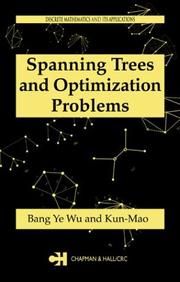
ISBN: 1584884363 9781584884361 Year: 2004 Publisher: Boca Raton (Fla.): Chapman & Hall/CRC,
Abstract | Keywords | Export | Availability | Bookmark
 Loading...
Loading...Choose an application
- Reference Manager
- EndNote
- RefWorks (Direct export to RefWorks)
Spanning trees play an important role in the design of efficient routing algorithms and help solve computationally hard problems like the Steiner tree and the traveling salesperson problem. This is one of the most important concepts used in graph theory, as it forms the foundation of many theoretical results in practical fields like scheduling, clustering, data mining, and many others. Spanning Trees and Optimization Problems is the first book published on the use and applications associated with the modern study of spanning trees. It covers properties of spanning trees first, followed by the three categories of spanning trees: minimum spanning trees, shortest-paths trees, and minimum routing cost spanning trees.
Book
ISBN: 9781466584518 1466584513 9780429103261 Year: 2015 Publisher: Boca Raton (Fla.): CRC,
Abstract | Keywords | Export | Availability | Bookmark
 Loading...
Loading...Choose an application
- Reference Manager
- EndNote
- RefWorks (Direct export to RefWorks)
"Graph-based approaches have been employed extensively in several disciplines such as biology, computer science, chemistry, and so forth. In the 1990s, exploration of the topology of complex networks became quite popular and was triggered by the breakthrough of the Internet and the examinations of random networks. As a consequence, the structure of random networks has been explored using graph-theoretic methods and stochastic growth models. However, it turned out that besides exploring random graphs, quantitative approaches to analyze networks are crucial as well. This relates to quantifying structural information of complex networks by using ameasurement approach. As demonstrated in the scientific literature, graph- and informationtheoretic measures, and statistical techniques applied to networks have been used to do this quantification. It has been found that many real-world networks are composed of network patterns representing nonrandom topologies.Graph- and information-theoretic measures have been proven efficient in quantifying the structural information of such patterns. The study of relevant literature reveals that quantitative graph theory has not yet been considered a branch of graph theory"-- "This book presents methods for analyzing graphs and networks quantitatively. Incorporating interdisciplinary knowledge from graph theory, information theory, measurement theory, and statistical techniques, it covers a wide range of quantitative graph-theoretical concepts and methods, including those pertaining to random graphs. Through its broad coverage, the book fills a gap in the contemporary literature of discrete and applied mathematics, computer science, systems biology, and related disciplines"--
Computer science --- Graph theory --- Combinatorial analysis --- Data processing --- Graph theory - Data processing
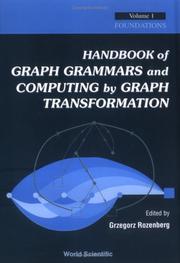
ISBN: 1281869589 9786611869588 9812384723 0585451435 9780585451435 9781281869586 9789812384720 9810228848 9789810228842 9810240201 981024021X Year: 1997 Volume: 1 Publisher: Singapore: World scientific,
Abstract | Keywords | Export | Availability | Bookmark
 Loading...
Loading...Choose an application
- Reference Manager
- EndNote
- RefWorks (Direct export to RefWorks)
Graph grammars originated in the late 60s, motivated by considerations about pattern recognition and compiler construction. Since then the list of areas which have interacted with the development of graph grammars has grown quite impressively. Besides the aforementioned areas it includes software specification and development, VLSI layout schemes, database design, modeling of concurrent systems, massively parallel computer architectures, logic programming, computer animation, developmental biology, music composition, visual languages, and many others.The area of graph grammars and graph tra
Graph grammars. --- Graph theory --- Grammars, Graph --- Formal languages --- Data processing. --- Graph grammars --- Data processing --- Graph theory - Data processing
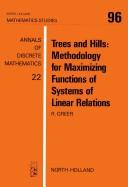
ISBN: 0444875786 9780444875785 9780080872070 0080872077 1281788147 9786611788148 Year: 1984 Volume: 22 96 Publisher: Amsterdam ; New York : New York, N.Y., U.S.A. : North-Holland ; Sole distributors for the U.S.A. and Canada, Elsevier Science Pub. Co.,
Abstract | Keywords | Export | Availability | Bookmark
 Loading...
Loading...Choose an application
- Reference Manager
- EndNote
- RefWorks (Direct export to RefWorks)
Trees and Hills: Methodology for Maximizing Functions of Systems of Linear Relations
Discrete mathematics --- Maxima and minima --- Functions --- Trees (Graph theory) --- Data processing. --- Data processing --- Graph theory --- Minima --- Mathematics --- Maxima and minima - Data processing --- Functions - Data processing --- Trees (Graph theory) - Data processing

ISBN: 3211821775 0387821775 3709190762 9783211821770 Year: 1990 Volume: 7 Publisher: Wien : Springer,
Abstract | Keywords | Export | Availability | Bookmark
 Loading...
Loading...Choose an application
- Reference Manager
- EndNote
- RefWorks (Direct export to RefWorks)
Computer science --- Discrete mathematics --- Graph theory --- Data processing --- 519.17 --- 681.3*G22 --- Graph theory. Trees --- Graph theory: graph algorithms; network problems; path and tree problems; trees--See also {681.3*F22} --- 681.3*G22 Graph theory: graph algorithms; network problems; path and tree problems; trees--See also {681.3*F22} --- 519.17 Graph theory. Trees --- Graph theory - Data processing
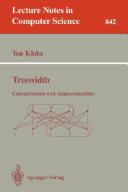
ISBN: 0387583564 3540583564 3540486720 Year: 1994 Volume: 842 Publisher: Berlin New York Springer-Verlag
Abstract | Keywords | Export | Availability | Bookmark
 Loading...
Loading...Choose an application
- Reference Manager
- EndNote
- RefWorks (Direct export to RefWorks)
This treatise investigates a number of problems related to treewidth and pathwidth of graphs. The main objective is to obtain good bounds on the complexity of determining the treewidth and pathwidth for various classes of graphs. Originating from the author's Ph.D. thesis, this monograph presents original own work. Nevertheless, many interesting perspectives beyond are presented. In total, the book is a smooth introduction to the topic of graphs of bounded treewidth. It will help to satisfy the strong interest among the algorithmic graph theory community in the theory pertaining to the topic. Particularly valuable is the thorough survey given of the relevant current literature.
Trees (Graph theory) --- Data processing --- Trees (Graph theory) - Data processing. --- Information theory. --- Computer software. --- Combinatorics. --- Computer graphics. --- Theory of Computation. --- Algorithm Analysis and Problem Complexity. --- Computer Graphics. --- Automatic drafting --- Graphic data processing --- Graphics, Computer --- Computer art --- Graphic arts --- Electronic data processing --- Engineering graphics --- Image processing --- Combinatorics --- Algebra --- Mathematical analysis --- Software, Computer --- Computer systems --- Communication theory --- Communication --- Cybernetics --- Digital techniques
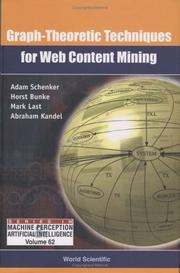
ISBN: 9812563393 9789812563392 9812569456 9789812569455 1281372579 9786611372576 Year: 2005 Volume: 62 Publisher: Hackensack, N.J.: World scientific,
Abstract | Keywords | Export | Availability | Bookmark
 Loading...
Loading...Choose an application
- Reference Manager
- EndNote
- RefWorks (Direct export to RefWorks)
This book describes exciting new opportunities for utilizing robust graph representations of data with common machine learning algorithms. Graphs can model additional information which is often not present in commonly used data representations, such as vectors.
Data mining --- Graph theory --- Algorithms --- Multidimensional scaling --- Data processing --- Information systems --- Discrete mathematics --- Data mining. --- Algorithms. --- Multidimensional scaling. --- Psychometrics --- Scaling (Social sciences) --- Algorism --- Algebra --- Arithmetic --- Algorithmic knowledge discovery --- Factual data analysis --- KDD (Information retrieval) --- Knowledge discovery in data --- Knowledge discovery in databases --- Mining, Data --- Database searching --- Data processing. --- Foundations --- Graph theory - Data processing
| Listing 1 - 10 of 21 | << page >> |
Sort by
|

 Search
Search Feedback
Feedback About UniCat
About UniCat  Help
Help News
News